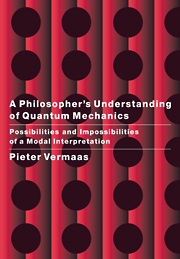 A Philosopher's Understanding of Quantum Mechanics
A Philosopher's Understanding of Quantum Mechanics Book contents
- Frontmatter
- Contents
- Preface
- 1 Introduction
- 2 Quantum mechanics
- 3 Modal interpretations
- Part one Formalism
- 4 The different versions
- 5 The full property ascription
- 6 Joint property ascriptions
- 7 Discontinuities, instabilities and other bad behaviour
- 8 Transition probabilities
- 9 Dynamical Autonomy and Locality
- Part two Physics
- Part three Philosophy
- Appendix A From the bi to the spectral modal interpretation
- Glossary
- Bibliography
- Index
7 - Discontinuities, instabilities and other bad behaviour
Published online by Cambridge University Press: 28 October 2009
- Frontmatter
- Contents
- Preface
- 1 Introduction
- 2 Quantum mechanics
- 3 Modal interpretations
- Part one Formalism
- 4 The different versions
- 5 The full property ascription
- 6 Joint property ascriptions
- 7 Discontinuities, instabilities and other bad behaviour
- 8 Transition probabilities
- 9 Dynamical Autonomy and Locality
- Part two Physics
- Part three Philosophy
- Appendix A From the bi to the spectral modal interpretation
- Glossary
- Bibliography
- Index
Summary
In this chapter I begin the discussion of the question of how the core properties of systems evolve in time. This question breaks up in two separate subquestions. Firstly, there is the question of how the set of all possible core properties of a system evolves. Secondly, one has the question of how, given this dynamics of the set of possible core properties, the actually possessed core property of that system evolves. Here, I consider only the first question of the dynamics of the whole set of core properties. In the next chapter I focus on the evolution of the actually possessed core property.
The modal interpretations that I consider ascribe core properties to systems by means of the spectral resolutions of states. The dynamics of the set of core properties is thus determined by the dynamical behaviour of these spectral resolutions. Study of the dynamics of the spectral resolutions now reveals a number of problematic features of the modal property ascription. Firstly, the set of the eigenprojections of a state Wα(t) can evolve discontinuously. Secondly, this set can evolve highly unstably. Finally, the eigenprojections of a state can evolve rather deviantly when compared with the evolution of the state itself. As a result of all this, the evolution of the set of core properties of a system can be discontinuous, unstable and deviant as well.
Discontinuities
Up to now I have only considered the property ascription to systems at single instants. It is now time to set things in motion.
- Type
- Chapter
- Information
- A Philosopher's Understanding of Quantum MechanicsPossibilities and Impossibilities of a Modal Interpretation, pp. 99 - 134Publisher: Cambridge University PressPrint publication year: 2000


